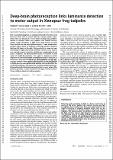Deep-brain photoreception links luminance detection to motor output in Xenopus frog tadpoles
Abstract
Nonvisual photoreceptors are widely distributed in the retina and brain, but their roles in animal behavior remain poorly understood. Here we document a previously unidentified form of deep-brain photoreception in Xenopus laevis frog tadpoles. The isolated nervous system retains sensitivity to light even when devoid of input from classical eye and pineal photoreceptors. These preparations produce regular bouts of rhythmic swimming activity in ambient light but fall silent in the dark. This sensitivity is tuned to short-wavelength UV light; illumination at 400 nm initiates motor activity over a broad range of intensities, whereas longer wavelengths do not cause a response. The photosensitive tissue is located in a small region of caudal diencephalon—this region is necessary to retain responses to illumination, whereas its focal illumination is sufficient to drive them. We present evidence for photoreception via the light-sensitive proteins opsin (OPN)5 and/or cryptochrome 1, because populations of OPN5-positive and cryptochrome-positive cells reside within the caudal diencephalon. This discovery represents a hitherto undescribed vertebrate pathway that links luminance detection to motor output. The pathway provides a simple mechanism for light avoidance and/or may reinforce classical circadian systems.
Citation
Currie , S P , Doherty , G H & Sillar , K T 2016 , ' Deep-brain photoreception links luminance detection to motor output in Xenopus frog tadpoles ' , Proceedings of the National Academy of Sciences of the United States of America , vol. 113 , no. 21 , pp. 6053-6058 . https://doi.org/10.1073/pnas.1515516113
Publication
Proceedings of the National Academy of Sciences of the United States of America
Status
Peer reviewed
ISSN
0027-8424Type
Journal article
Description
SPC was supported by a BBSRC studentship.Collections
Items in the St Andrews Research Repository are protected by copyright, with all rights reserved, unless otherwise indicated.

